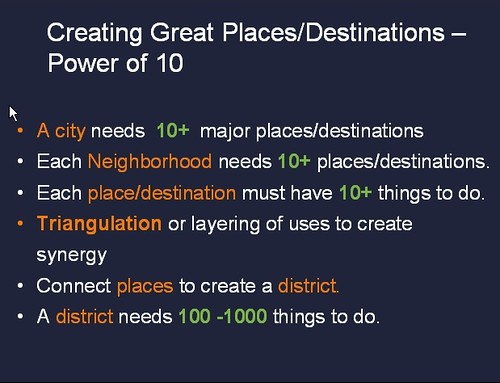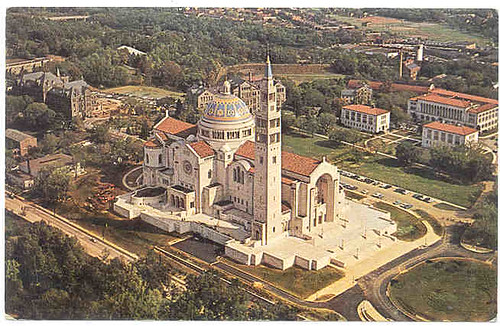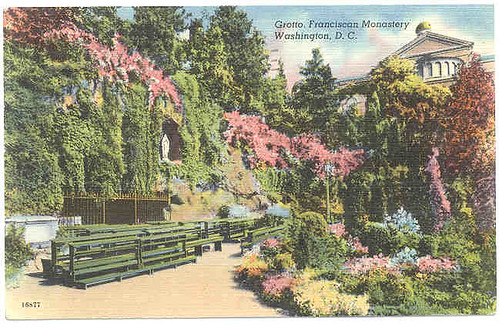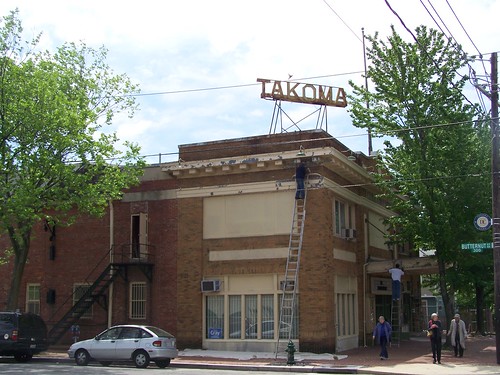Where's the there? To get visitation to neighborhoods there must be destinations worth visiting
One of my earliest blog entries is entitled, "Town-City branding or 'We are all destination managers now'."
It's based on my then realization that commercial district revitalization and arts and culture and historic preservation efforts are at the root, about destination development, hence the point I make that "we are all destination managers now."
A couple years before then I had been introduced to the concept of the cultural landscape and heritage areas along with heritage tourism (went to a bunch of good conferences and workshops).
It turns out that concepts from tourism development--although the definition of tourism is trips that involve staying overnight--are applicable to destination development more generally.
I do believe that one of the points I made in that piece is that the city's tourism tax revenue stream (hotel taxes, rental car taxes, meal taxes, maybe a wee bit of the parking tax) should in part be used to support the development, management, and operations of cultural assets at the neighborhood level.
Instead, most of the money is used to pay the debt on the Convention Center and for the operation of the city's "CVB" (convention and visitors bureau), Destination DC. Although, Destination DC does provide some grants to organizations such as CulturalTourismDC to support tourism-related activities by those organizations.
Former DC resident Kathy Smith, founder of what is now called CulturalTourismDC, was a leader in the development of this field locally. Her book, Capital Assets, reviews neighborhoods in DC and listed them in terms of what is called "destination readiness," listing the various cultural assets that are there, either in use or able to be, and discusses their possibilities. (article)
And a few years later, in a conversation with Steve Moore, then the director of the DC Economic Partnership, he made a very apt point, that special events like street festivals deserved a lot more support from the city then they typically get, because of how they draw people into the city, but especially to neighborhoods.
 Adams-Morgan Day of course is the primary example, but Mount Pleasant Day used to be a great event, and now the H Street Festival may well be the most attended neighborhood festival in the city, and is a key element of the re-branding and repositioning of the H Street commercial district as an entertainment destination.
Adams-Morgan Day of course is the primary example, but Mount Pleasant Day used to be a great event, and now the H Street Festival may well be the most attended neighborhood festival in the city, and is a key element of the re-branding and repositioning of the H Street commercial district as an entertainment destination.Left: H Street Festival, Flickr photo by Edward Hoover.
Today, the Examiner has a piece, "D.C. leaders want arts spending to get tourists into neighborhoods," about how the city's elected officials want arts and culture to be used to drive neighborhood visitation, and the DC Economic Partnership's e-letter, Elevation DC, has a piece about theaters as elements of neighborhood revitalization, "The art of development: how theaters can catalyze growth." From the Examiner:
But as Mayor Vincent Gray plans to significantly increase the District's funding for the arts, local leaders are plotting art installations that might draw tourists off the National Mall and into undertrafficked neighborhoods.
At-Large Councilman David Grosso mused that D.C. needs a distinctive piece of art all its own. Just like Chicago has "The Bean" (officially titled Cloud Gate), a shiny, odd-looking, permanent fixture of Millennium Park that draws flocks of gaping onlookers, the District needs its own distinctive centerpiece, he reasons -- not another obelisk for a former president.
While of course I agree with the sentiment behind some of this, most of the neighborhoods don't have places to go and see, other than being able to walk around and look at a neighborhood's architecture.
Hopefully there are restaurants and a decent commercial district, but until recently that wasn't necessarily the case in many neighborhoods across the city. See by contrast "Framingham's Amazing Things Arts Center," "First Fridays Artswalk energizes downtown Pittsfield," and "Wilco’s festival returns to Mass MoCA for a third time" from the Boston Globe.
We need a city-wide cultural plan
We don't have an overall city cultural plan. I was one of the people who advocated for the creation of a cultural element to the City's Comp Plan back in 2004, and one was created, but because it is a grab bag o' stuff, rather than an integrated whole, I disavow any connection.
So first we ought to have an overall plan. Parks, public art, cultural assets, architecture etc. must be addressed systematically and integrated, rather than throwing up some half-assed art sculptures and murals (there are some godawful murals out there).
Some places, like Arlington County, include cultural plans within their "parks master plan," while other jurisdictions have separate plans. Historic preservation and libraries are key elements to broader cultural planning as well.
I write about the need for such a plan here, "Cultural resources planning in DC: In the land of the blind, the one-eyed man is king," and opine that all the various failures of arts centers (like the City Museum, Lincoln Theater, the earlier incarnation of the Source Theater) derives from the lack of a plan and coordinated system of development and funding.
 A city-wide cultural plan should include sub-plans for sectors and neighborhoods
A city-wide cultural plan should include sub-plans for sectors and neighborhoodsSecond, this non-existent plan should drill down, comparable to how Capital Assets did, and provide cultural and civic asset plans at the sector or neighborhood level.
This piece, "The layering effect: how the building blocks of an integrated public realm set the stage for community building and Silver Spring, Maryland as an example," about Silver Spring, Maryland, outlines an approach to creating comprehensive "neighborhood" or district-scaled culture plans.
That piece includes discussion about other planning approaches, including Project for Public Space's concept, The Power of 10.
Note that some people argue that libraries are declining in significance and importance as an element of cultural planning for districts and neighborhoods. I disagree, but there is no question that libraries have to change with the times. Also see "What good are libraries" from Digital Communities.
 You can see the problem of a failure to have sector-neighborhood culture plans in a neighborhood like Brookland, which has a fair number of cultural assets, yet they are discoordinated.
You can see the problem of a failure to have sector-neighborhood culture plans in a neighborhood like Brookland, which has a fair number of cultural assets, yet they are discoordinated. They have the National Shrine (pictured in the postcard image at right) and the Franciscan Monastery, both of which are highly visited by people from across the nation.
Arguably, some of the other colleges and Catholic institutions there, such as Catholic University and St. Paul's College, can attract visitors. (There's also the failed Pope John Paul II Cultural Center, that's another story.)
 But you also have Dance Place, CUA's Hartke Theater, and DCTV, the public access cable tv channel operation. In the development of the Brookland Small Area Plan, I recommended that Dance Place and Hartke Theater relocate to the proposed Monroe Street spine, that DCTV take on a more public role (the building, one of the oldest farmhouses still extant in Upper Northeast has mostly renovated everything original away, except for the facade), and that CUA relocate its arts-related academic departments to the part of the campus closest to Monroe Street. That hasn't happened.
But you also have Dance Place, CUA's Hartke Theater, and DCTV, the public access cable tv channel operation. In the development of the Brookland Small Area Plan, I recommended that Dance Place and Hartke Theater relocate to the proposed Monroe Street spine, that DCTV take on a more public role (the building, one of the oldest farmhouses still extant in Upper Northeast has mostly renovated everything original away, except for the facade), and that CUA relocate its arts-related academic departments to the part of the campus closest to Monroe Street. That hasn't happened.And the arts-promoting elements of the Monroe Street Market development, while really cool, have been done in the absence of an overall Brookland cultural plan, so while they will be interesting additions to cultural life in Brookland and the city, some of the potentially positive multiplicative impact will not be realized.
Another example is the continuing debacle over how to make the Downtown Martin Luther King Jr. Library better, as has been discussed more recently ("Gray Funds Renovation of Martin Luther King, Jr. Memorial Library" from DCist). I was thinking about one of my old pieces on this, "Central Library Planning efforts and the City Museum, how about some learning from Augusta, Maine ... and Baltimore?"," which proposed combining the city's archives and visitor functions with a broader cultural complex along with the library.
Or the lack of a "recreation center" downtown as well since the closure of the YWCA that was located across the street from the Library (the Y had the only deep water full length swimming pool downtown). Throw a recreation facility into an expanded "Library" as well.
 But there are many such examples of this problem across the city, from the relative failure of U Street's Lincoln Theater under city ownership to the recalcitrant owners of the Takoma Theatre, who let the building sit empty and mouldering.
But there are many such examples of this problem across the city, from the relative failure of U Street's Lincoln Theater under city ownership to the recalcitrant owners of the Takoma Theatre, who let the building sit empty and mouldering.One more thing: ways to visit houses
DC has some house-type museums.
When we travel ourselves we check out house museum tours (and sometimes estate sales and real estate open houses too, as a way to see houses) ... even though as an element of cultural tourism house museums have declined as visitorship has dropped. See "Old Sweet House Museum" from Old House Journal and papers from the symposium "American House Museums in the 21st Century." The workbook, Great Tours, offers a way for house museums to punch up their work also.
Although house tours in places like Charleston and Savannah are as popular as ever.
 Rowhouses are such a distinctive element of DC's residential architecture. I know my first gaze on rowhouses when I first visited Washington about 40 years ago certainly stuck with me.
Rowhouses are such a distinctive element of DC's residential architecture. I know my first gaze on rowhouses when I first visited Washington about 40 years ago certainly stuck with me. Since most people who visit DC are unfamiliar with rowhouses, it would be nice for there to be a rowhouse or two which people could tour, such as in Georgetown, Capitol Hill, or Dupont Circle.
Looking at the visitor experience and set of preferences, identifying and then filling gaps in the experience should be a priority in developing district scaled arts and culture plans.
The arts and culture plan should also have sub-elements for each creative discipline
This piece, "Arts, artistic production, and culture districts revisited," which was the basis of a presentation I did at the 2009 conference for the Literary Managers and Dramaturgs of America, takes the argument into new directions, and suggests that as part of broad cultural planning, each artistic discipline should have a plan as well. A big part of the presentation is about the types of spaces that creative production requires and how to provide them.
Conclusion
Without a plan, the ad hoc dis-coordinated often wasteful system we've got now will continue.
This is one of the problems with how we focus on best practice examples from other places, like Millennium Park in Chicago or the High Line in New York City.
Without really understanding how these parks fit in with the overall scheme of parks in those respective places, it's easy to focus on one or two elements, such as "the Bean" as a sculpture, rather than how the Millennium Park fits in with waterfront parks and culture assets in Chicago, is adjacent to Downtown, is part of a cluster of assets, is an element of the Chicago Parks District, etc.
... For what it's worth, years ago I suggested that maybe instead of rebuilding as "CityCenter DC" the place where the Convention Center was, DC could build a Millennium Park of its own. See "Public Squares and DC."
Labels: arts-culture, commercial district revitalization, community building, community organizing, libraries, participatory democracy and empowered participation, public realm framework, urban design/placemaking




13 Comments:
Yes, best practices can very easily become "We want shiny stuff".
In terms of house tours, you've got a lot of existing stuff. Same for another number of other "cultural" tourist events (lectures, talks, embassy events, etc) which is why I saw DC is the most "cultural"city in the US.
Not sure the street festivals are much better than say the Fourth of July or Cherry Blossom in terms of leveraging the city.
(as opposed to say Miami Music festival, jazzfest, sxsw, etc)
The national stuff is different from the local-neighborhood stuff.
Actually, I think DC has some difficulties marketing neighborhood vs. national cultural heritage.
For one, people define the city in terms of the national story. I think because so many people come here for that, it's tough to get them to stay another day or two to see the "local" side, other than experiencing a wee bit of it while eating/partaking of commercial districts for dinner--like Georgetown, Dupont Circle, maybe H St. etc.
To get people to visit longer (other than other residents in the region), the local side of the cultural heritage equation needs to be better. A distinctive piece of public art in and of itself isn't enough.
Right, not my most cogent comment.
Let me rephrase it this way, and let you unpack.
The problem with tourism in Washington is that most people don't spend a lot of money here. It is Disneyworld without the entrance fees.
That is very true with people on the Mall. But very true for all the big days (Obama inauguration, cherry blossom, 4th july, etc)
And I get that the "federal" parties don't really brand anything local, although I doubt the Cherry Blossom is "federal".
However, the various street festivals have somewhat the same problem -- pretty low spending crowd. * They do brand slightly better, however. They aren't cultural, however. Various Smithsonian festivals have the same problem.
Cultural is also a way to say "a bit more high end".
And that is what we don't have event that brings people from around the world into town and spend "Cultural" money.
And maybe we don't need that, since we've got people coming in all the time, but it isn't cultural it is "journalists, media, bloggers, lobbyists, professors, head of state" and the one thing they really just want is a cocktail.
* Alcohol not included!
well, "all" I can say is that what you write illustrates the trickiness of the issue and why "plans"-overarching policies are needed.
It's a lot more than just putting in a DC Bean.
I like the video-water sculpture, Crown Fountain, myself.
http://en.wikipedia.org/wiki/Crown_Fountain
It happens I will be blogging about this topic again, because of a related planning initiative in PGH, that I found out about after I wrote the other stuff. Although it is focused on public art, it will be doing neighborhood level planning for it.
Meant to comment recently and suggest that you market yourself to Mayor Gray and Company to develop such a plan. Now seems like a perfect time to do so, don't you think?
EE
http://washingtonexaminer.com/d.c.-leaders-want-arts-spending-to-get-tourists-into-neighborhoods/article/2526017
Oh, and another thing, Foggy Bottom/West End has been pretty creative in this regard.
EE
Six-month outdoor sculpture exhibition:
http://www.foggybottomassociation.com/arts/
And you thought everything about Duke Ellington was on U Street:
http://westendfriends.org/dukepark.htm
very interesting blog,nice information.your work is very excellent.click it...: https://www.dosepharmacy.com
Blogs have always been my source of entertainment because I just love leather jacket women reading and your blog has made me contended. So keep up the good work.
A heartfelt thank you to the blog creator for your insightful and impactful content. Your dedication to providing valuable information has not gone unnoticed. Your work is a source of inspiration and knowledge, enriching the online space. Appreciate the effort you put into crafting meaningful and engaging articles. ganesha tanjore painting
Wondering where your package is right now? With DHL Courier Tracking, you’re never left guessing. Whether you’re a business shipping urgent documents or a family sending gifts across India, DHL’s intuitive tracking system puts real-time updates at your fingertips. At DHL Courier India, we make tracking effortless, transparent, and stress-free—because every shipment deserves a smooth journey.
In Chennai’s vibrant educational landscape, International preschool in chennaii are redefining early childhood experiences by blending global perspectives with local values. For discerning parents seeking more than traditional learning—a space where curiosity crosses borders, cultures connect, and creativity thrives—Squad School stands as a beacon of excellence. Our Chennai campus nurtures young minds to become confident, compassionate global citizens, right from their first steps into education.
Partner with TranzNova for end-to-end Network Global Logistics solutions that simplify international shipping. We specialize in air/ocean freight, customs clearance, and real-time tracking—ensuring your cargo moves efficiently across 190+ countries. With cutting-edge technology and personalized support, we transform complex logistics into competitive advantages. Trusted by exporters, importers, and e-commerce giants, TranzNova delivers reliability, speed, and cost transparency.
Discover premium Acrylic Sheet at Arona Store – your trusted UAE source for versatile, crystal-clear material perfect for signage, displays, DIY projects, and more! Our sheets offer unmatched durability, UV resistance, and effortless shaping for both home and commercial use.
Post a Comment
<< Home